Chem. Soc. Rev.:单一手性等离激元纳米晶的最新研究进展
从几何角度看,手性物体不具有镜平面或反对称性。它显示出与其镜像(对映异构体)不同的物理化学特性。最近研究进展已经发现单个手性等离激元纳米晶具有优异的光学性质,这种手性光学活性与其局部表面等离激元共振现象密切相关。在这篇综述中,香港理工大学Kwok-yin Wong 教授、西班牙科学院CICbiomagune研究所Luis M. Liz-Marzán 教授、西班牙比戈大学Jorge Pérez-Juste 教授、郑州大学郑广超博士和瑞士洛桑联邦理工学院何吉骏博士等在Chemical Society Reviews (IF=42.84)总结了湿化学方法合成具有单个手性等离激元纳米晶的最新进展,并讨论了其等离激元手性的起源,以及为解释它而提出的理论模型。最后,他们讨论了单个手性等离激元纳米晶的应用进展。
通常,仅通过将手性分子放置在等离激元纳米晶表面附近即可产生等离激元纳米结构的手性光学响应。但是,由于手性分子与等离激元纳米晶的弱耦合强度,使得等离激元圆二色光谱(plasmonic CD,PCD)效应相对较弱。国内外已经有诸多的课题组通过操纵这种分子-等离激元纳米晶之间的相互作用来实现增强、稳定和可调的PCD效应。目前为止,关于手性等离激元纳米晶光学活性的研究主要集中在两方面:(一)将手性分子有选择地置于两个非手性等离激元纳米颗粒(NPs)之间,即“热点”,而产生不同的PCD响应;(二)另一种有效的方法是以手性有机支架(例如肽、DNA折纸术或有机胶凝剂)可作为软模板,用于制造具有强手性光学活性的3D螺旋阵列的手性等离激元纳米结构。但是这些制备出来的手性等离激元纳米结构依然存在着局限性,如:制备方法难以精确控制、手性光学活性的稳定性和手性等离激元耦合等问题。基于理论推测和实验,获得的不同构型的单个手性等离激元纳米晶的能够克服上述局限性,能够拓展手性等离激元纳米光子学的研究。物理法虽然能够自上而下的制备单个手性等离激元纳米结构,但是洁净室、高成本物理仪器限制了它们的大规模合成。因此本综述的作者们从单个手性等离激元纳米晶方面重点调研了其手性来源、制备以及潜在应用。
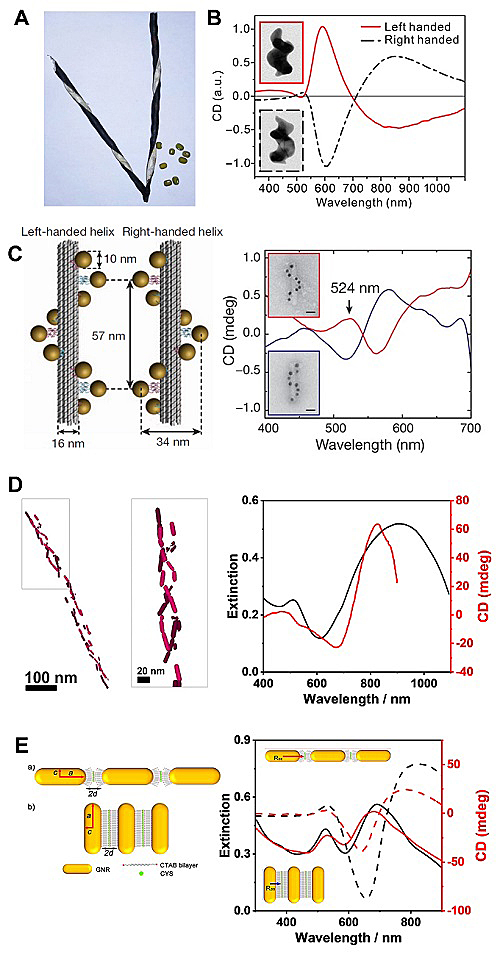
Figure 1. Examples of chiral (nano)structures. (A) Photograph of chiral pods of green beans. (B) Chiroptical response of Au nanohelices fabricated by lithography. (C) Left: Scheme of nanohelices obtained via DNA origami-directed self-assembly of 10 nm Au nanoparticles. Right: Circular dichroism of left-handed (red line) and right-handed (blue line) nanohelices. (D) Left: Cryo-TEM tomography reconstruction of a 3D chiral arrangement of Au nanorods on an α-synuclein fibril and enlarged view of the top part of the assembly. Right: extinction and CD spectra of a colloidal dispersion of Au nanorod/α-synuclein self-assembled fibers. (E) Left: Diagram of Au nanorods in end-to-end, EE, (a) or side-to-side, SS, (b) assemblies, mediated by cysteine and CTAB. Right: Comparison of the optical properties of EE (black lines) and SS (red lines) assembled Au nanorods.
离散等离激元NP的手性来源
作者们简要讨论与单一等离激元晶中的手性起源有关的基本理论。首先,当金属纳米粒子非常小(尺寸<<波长)时,手性分子与金属纳米粒子之间的相互作用被认为是偶极-偶极相互作用。在这种准静态近似中,可以得出CD(包含CD分子和PCD)的分析表达式。然后,当金属纳米颗粒与波长(≥100 nm)相当时,该近似不再有效,并且延迟效果变得明显。在这种情况下,电动方程可以写成几种不同的本构关系。在一定的本构关系下,可以推导手性分子的介电常数和磁导率。最后,等离激元纳米晶手性的起源可能来自纳米粒子本身的手性形态,而不是手性转移,并将描述用于该理论计算的模型。
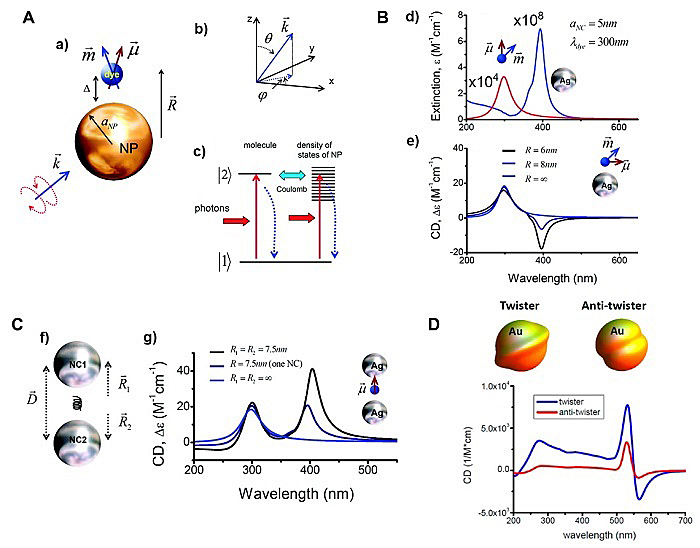
Figure 2. (A) Scheme of a complex made of a metal nanoparticle and a dye molecule (a). R→denotes the vector connecting the centers of both nanoparticle and molecule. (b) System of coordinates and the definition of polar angles used in the formulation. (c) Quantum transitions in the system; the solid vertical (horizontal) arrows represent light (Coulomb)-induced transitions. The dotted vertical arrows are the relaxation processes. (B) Complex made of an Ag NP and a dye molecule. (d) Extinction spectra of a molecule alone and a Au NP alone. (e) Calculated CD spectra for Ag NP-molecule complexes with three different molecule-NP distances, R, as indicated. (C) Model of a system made of a NP dimer and a chiral molecule (f). (e) Calculated CD spectra of a dimer-molecule complex for R1= R2 = 7.5 nm and for R1= R2= ∞, being R1 and R2 the distances between the molecule and each NP in the dimer. The calculated CD spectrum for a single NP and R = 7.5 nm is also shown. (D) Scheme of a right-handed twister and an antitwister Au NP with an average radius (R0) of 7 nm and amplitude of radius variations (δR) of 1.5 and −0.8, respectively, together with the calculated CD response for both chiral Au NPs.
离散手性等离激元NP的合成
在本节中,作者们总结了迄今为止已提出的制备不同构型的单一手性等离激元纳米晶的湿化学方法,大致可以归为两类:金属-手性分子-金属(metal-molecules-metal, 3M)纳米结构和具有扭曲的手性形态的等离激元纳米晶。在前者构型中,将非手性金属种子引入到含有手性分子的生长溶液中,该手性分子具有对金属纳米颗粒表面具有亲和力的官能团,从而导致手性转移。有趣的是,在金属-手性分子-金属构型中,种子的二次生长导致手性分子埋葬于热点(纳米间隙和纳米空穴)当中,获得场增强的手性光学响应。在后者构型中,种子的二次生长过程当中,受到外部手性刺激物(如手性分子或圆偏振光)诱导纳米晶表面的手性形态,获得具有扭曲的手性形态的等离激元纳米晶。
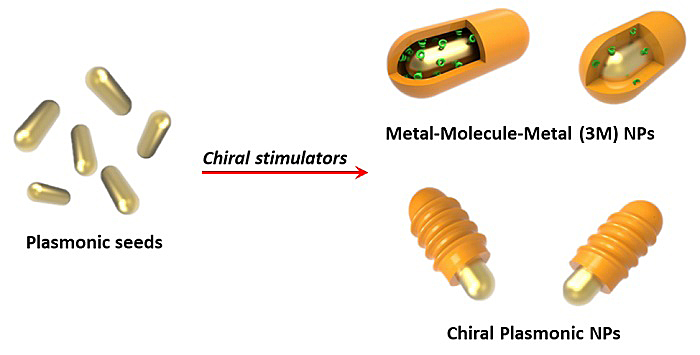
Scheme 1. Schematic representation of the two main strategies for the synthesis of chiral plasmonic nanoparticles, based on the seeded growth of pre-synthesised plasmonic seeds: Metal-Molecule-Metal (3M) NPs and Chiral Plasmonic NPs.
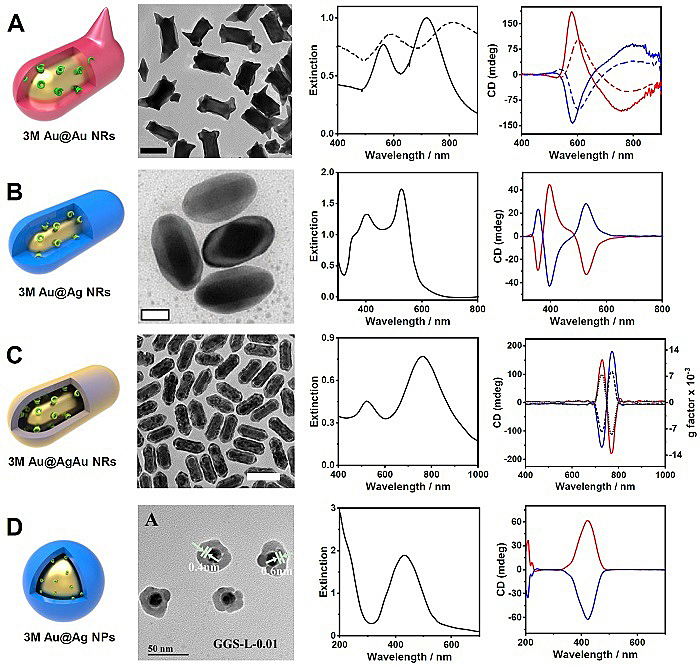
Figure 3. Schematic representation of different 3M chiral NPs, together with representative TEM images and corresponding extinction and CD spectra. (A) Au@Au core-shell nanorods synthesized in the presence of L- or D-cysteine (Scale bar: 100 nm). The dashed lines correspond to the same system after coating with silica, showing a red-shift in both extinction and CD spectra. (B) Au@Ag core-shell nanorods synthesized in the presence of L- or D-cysteine (Scale bar: 20 nm). (C) Au@AgAu yolk-shell nanorods synthesized in the presence of L- or D-penicillamine (Scale bar: 100 nm). The dashed lines represent the estimated g-factors. (D) Au@Ag core-shell spheres synthesized in the presence of cytosine‐rich single‐stranded DNA.
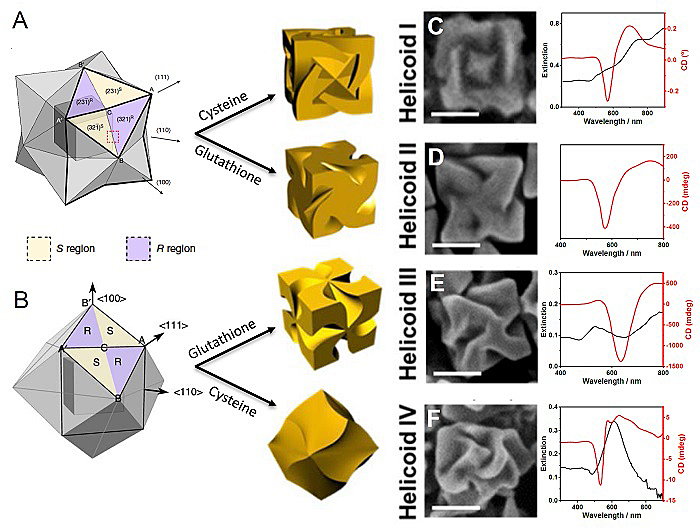
Figure 4. (A-B): Schematic representation of a stellated octahedron (A) and rhombic dodecahedron (B), differentiated by high-index facets consisting of S region and R region configurations, and the respective evolution of these nanostructures into different helicoids induced by the presence of cysteine and glutathione, as indicated. (C-F) Representattive SEM images and the corresponding UV-visible and CD spectra of: 432 Helicoid I (C), 432 Helicoid II (D), 432 Helicoid III (E), and 432 Helicoid IV (F).
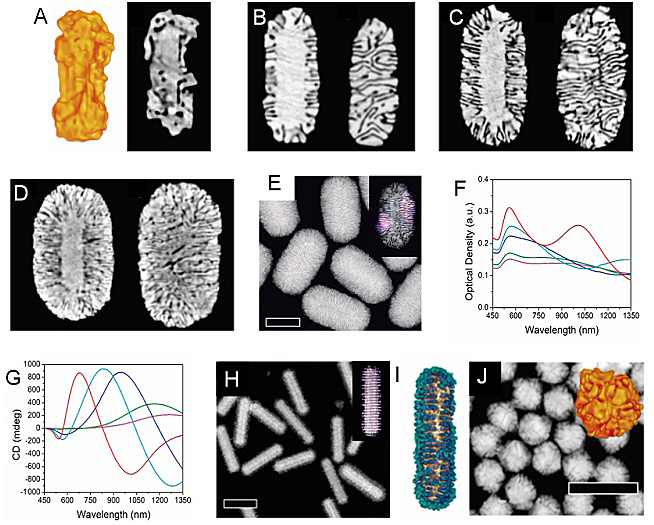
Figure 5. Chiral nanorods templated by helical surfactant micelles. (A) Tomography reconstruction of a gold nanorod overgrown in the presence of (R)-BINOL (left) and a selected orthoslice (right). (B-D) Orthoslices through 3D reconstructions from different chiral nanorods synthesized in the presence of (R)-BINAMINE, with sizes 165x73nm (B), 210x112nm (C), 270x175nm (D), revealing the presence of the central NR (left) and a radial wrinkle network (right). (E) HAADF-STEM Image of chiral 210x112nm nanorods (scale bar: 100 nm) and an exemplary inverse FFT showing the areas of particle with chiral features, indicating right handedness (inset). (F,G) Vis-NIR (F) and CD (G) spectra of chiral nanorods with varying particle dimensions: 165x73nm (red), 200x92nm (cyan), 250x145nm (green), 270x175nm (magenta). (H) HAADF STEM Image of Au@Pt wrinkled nanorods (scale bar: 100 nm) and inverse FFT (inset). (I) Tomography reconstruction of Au@Pt nanorods in EDX mode, showing the pattern of Pt grooves (cyan) on the central Au NR (golden); (J) HAADF-STEM Image of chiral nanospheres and a 3D reconstruction (inset).
离散手性等离激元NP的潜在应用
单一手性等离激元纳米晶的手性光学特性使它们对左旋或右旋圆偏振光具有选择性。因此,基于此优势,科学家们将注意力集中在具有圆极化相关的特征的相关应用的开发上,作者将重点总结了传感、圆偏振光催化、光动力疗法等相关的应用。
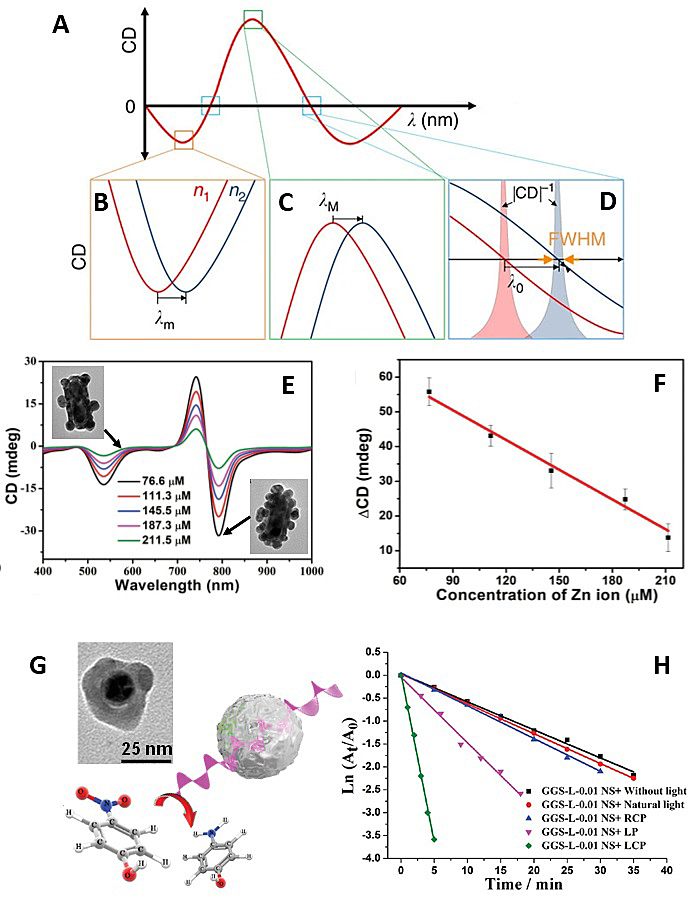
Figure 6. (A-D) Chiral plasmonic sensing. (A) CD spectrum of a plasmonic enantiomer as a function of wavelength. (B-D) Resonance shifts at the minimum λm (B), maximum λM (C) and half maximum λ0(D), where the refractive indices of the surrounding media are varied from n1 to n2. (E-F) CD spectral changes with different concentrations of intracellular Zn2+ (E) and calibration curves for Zn2+ detection (F), where ΔCD = CD740 nm − CD795 nm. The insets in (E) are representative TEM images showing a decrease in the number of Au satellites in the assembly with increasing concentration of Zn2+ ions. (G-H) Schematic representation of the circularly polarized photocatalysis of 4-nitrophenol to 4-aminophenol by 3M Au@Ag chiral NPs (G). The inset shows a representative TEM image of a 3M Au@Ag chiral NP. (H) Kinetic trace (plot of Ln (At / A0) as a function of time) for the reaction catalyzed by 3M Au@Ag chiral NPs under different light conditions (RC, L and LC stand for right-circularly, linear and left-circularly polarized light, respectively).
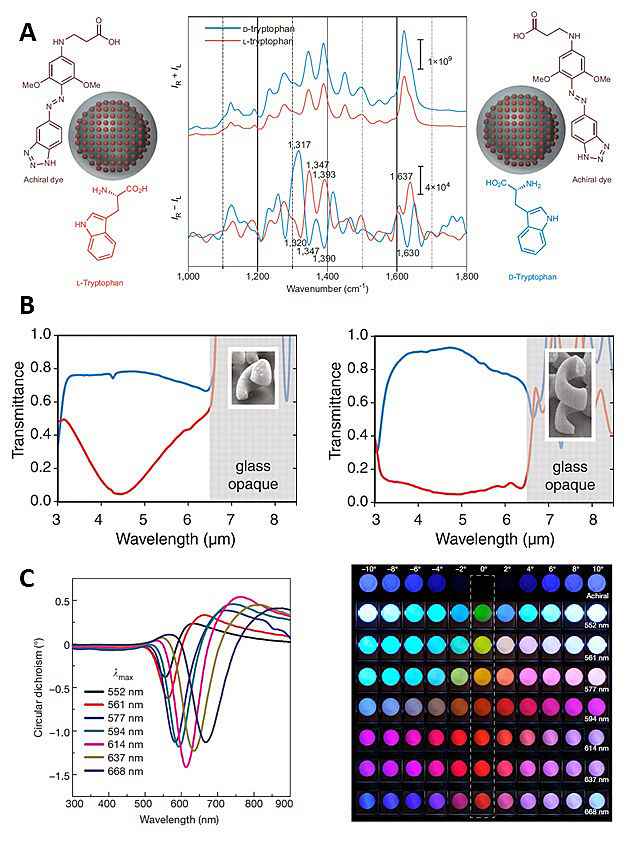
Figure 7. (A) Chirality transfer from a chiral analyte to an achiral reporter. The SERRS (resonant SERS) spectra (top) of D- and L-tryptophan bound to benzotriazole-functionalized nanotags are identical — as expected for two enantiomeric systems. Surface-enhanced resonant Raman optical activity (SERROA) spectra (bottom) for both systems show strong chiroptical responses that are attributed to the achiral dye. IR and IL are the intensities of right- and left-polarized light, respectively. (B) Transmittance spectra measured through a photonic metamaterial composed of a 2D square lattice of slightly less than one pitch of left-handed helices (left) and two pitches of left-handed helices (right). Red and blue spectra correspond to the illumination with right- and left-handed circular polarization, respectively. (C) (Left) CD spectra of Au helicoid NPs for different values of λmax (the wavelength of maximum g-factor) and (Right) polarization-resolved colours of light transmitted through seven different Au helicoid NPs dispersions with different λmax values (shown in the corresponding CD spectra) and an achiral nanoparticle solution (top row).
总结与展望
单一的手性贵金属纳米晶具有强且可调节的光学活性,作者们总结了它们的手性来源、制备方法以及应用,暗示了它们具有巨大潜力。尽管如此,在可靠的理论模型和实际应用中,该领域仍有许多工作要做。作者们重点介绍了几个研究方向,这些方向在不久的将来似乎特别重要。手性分子靠近,接触或嵌入非手性等离激元纳米颗粒中的位置导致在LSPR波长(通常在可见光和NIR范围内)下,由等离激元诱导的手性和CD响应。然而,需要更全面的理论来解释将手性分子在纳米颗粒上的定位和取向与它们的手性光学活性相关联。尚未有足够的理论来研究手性分子的性质及其与等离激元场的耦合方式在手性光学中的影响。除了分子的吸收介导的手性反应以外,应该探索分子和纳米颗粒的折射率的影响。大多数研究仍集中在金纳米晶上,但其他等离激元金属和介电材料,包括银、铝或钯,将值得探索。开发新颖的合成方法以获得具有高形态和化学稳定性以及强手性光学活性的单一的手性贵金属纳米晶,可以扩展其在不同技术中的适用性。关于3D手性纳米粒子的合成,仍需要对其形状和大小进行更好的控制,以在更宽的光谱范围内实现可调手性响应。此外,了解此类胶体颗粒中手性的起源对于进一步探索有效的合成方法至关重要。3D手性纳米粒子的消光光谱与其手性之间的关系应更详细地研究。另一个必将引起更多关注的主题是手性等离激元纳米粒子的定向组装,以及该过程在基于等离激元耦合产生的手性反应中的意义。在这种情况下,具有质子手性的刺激响应性自组装NP的发展值得特别关注。DNA纳米技术和其他刺激性自组装方法必将被用于合成手性质子纳米结构,以进一步应用于传感,催化或信息存储。
本工作得到了国家自然科学基金项目(21902148)、西班牙科学与创新部 (PID2019-108954R)、ERC Advanced Grant (No. 787510) (4DbioSERS)、香港理工大学等项目资助.
原文(扫描或长按二维码,识别后直达原文页面,或点此查看原文):

Discrete metal nanoparticles with plasmonic chirality
Guangchao Zheng, Jijun He, Vished Kumar, Shenli Wang, Isabel Pastoriza-Santos, Jorge Pérez-Juste*, Luis M. Liz-Marzán* and Kwok-Yin Wong*
Chem. Soc. Rev., 2021, DOI: 10.1039/C9CS00765B
主要作者简介

黄国贤教授是香港理工大学副校长,应用化学领域的Patrick S.C. Poon冠名教授,化学技术的讲座教授,生物学和药物国家重点实验室主任。黄国贤教授在香港理工大学获得了其化学学士学位和博士学位。随后,他在加州理工学院(美国)从事博士后研究工作。于1990年,他加入了香港理工学院(香港理工大学前身)。他的研究兴趣主要包括电催化,光催化,绿色化学,生物传感器和抗生素的发展。

Luis M. Liz-Marzán教授是Ikerbasque教授与西班牙科学院CIC biomaGUNE研究所所长(2012-Now)。他毕业于圣地亚哥联合大学化学专业,曾在乌得勒支大学做博士后研究,并晋升为比戈大学教授(1995–2012)。他是西班牙皇家科学院和欧洲科学院院士,并取得了许多世界纳米领域内认可的其他奖项。Liz-Marzán教授被认为在金属纳米晶体的胶体合成和自组装中,及其等离激元的表征和应用特性中做了许多先锋性工作。他最近的研究专注于等离激元纳米结构在生物医学应用方面的应用。

Jorge Pérez-Juste教授于1999年在取得博士学位。然后,他在墨尔本大学(2001–2002)从事博士后研究。他目前是比戈大学(西班牙)CINBIO的副教授。他的研究专注于制备和表征金属纳粒子以及理解纳米粒子的生长机制。此外,他的研究还涉及纳米粒子在催化和传感中的应用。
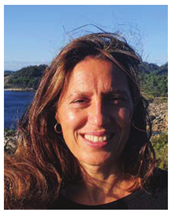
Isabel Pastoriza-Santos教授于2001年在比戈大学(西班牙)获得她的化学博士学位。她在墨尔本大学(澳大利亚)(2002-2003)从事博士后研究员工作。2004年获得比戈大学的博士后研究员职位。2009年,她获得了比戈大学物理化学系的教职工作。目前她已经合著发表大于145篇的科研论文。她的研究领域主要包括等离激元纳米颗粒和纳米复合材料的制备及其在传感和催化中的应用。
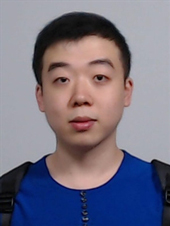
何吉骏博士于2013年获得中国科学技术大学的物理学士学位。在2019年在香港理工大学获得博士学位,博士导师为谭华耀教授。然后他在瑞士洛桑联邦理工学院Tobias Kippenberg教授课题组进行博士后研究(2019-至今)。他目前的研究领域主要为基于集成非线性光学微腔的频率梳产生及其应用。

郑广超博士于2012年获得中国科学技术大学的化学硕士学位。在2015年在比戈大学(西班牙)获得博士学位,博士生导师是Jorge Pérez-Juste 和Luis M. Liz-Marzán教授。然后他在香港理工大学作博士后研究(2016-2019)。2019年他加入到郑州大学物理学院。他目前的研究领域主要包括以结构为导向的贵金属纳米粒子的表面增强光谱学(SERS / SEF),光电催化和手性纳米光子学。
如果篇首注明了授权来源,任何转载需获得来源方的许可!如果篇首未特别注明出处,本文版权属于 X-MOL ( x-mol.com ), 未经许可,谢绝转载!












































 京公网安备 11010802027423号
京公网安备 11010802027423号